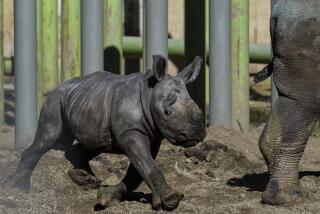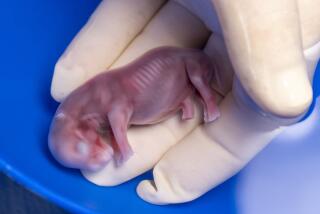Come into my mud pool
- Share via
Way Kambas National Park, Indonesia — PROMOTING the sex life of a stud Sumatran rhino from Los Angeles is an intricate affair involving mud, massages and frequent foot rubs. His species may be heading for extinction, but a male still has needs.
So Andalas, who flew here from the Los Angeles Zoo in February, is getting the pampered treatment from his Indonesian keepers. They hand-feed him his favorite ficus leaves, play hide-and-seek with him in the rain forest, gently nuzzle him nose to horn, and massage his cracked feet along with the soft spots of his ample butt.
“That’s a good boy,” they coo to the 1,540-pound beast in English, as he closes his eyes, softly snorts and soaks up the love.
The keepers hope all the affection will improve the odds that Andalas, the first Sumatran rhino born in captivity in 112 years, will soon sire offspring in his new home in a rhino sanctuary on the Indonesian island of Sumatra.
While they watch to see how the 5-year-old performs, the pressure is building: Nothing less than the future of a species that has dwindled to about 300 animals in the wild may be riding on his hairy shoulders.
Poachers and illegal logging have decimated the Sumatran rhino population, killing an estimated 70% of the species in the last two decades. Illegal trafficking in the animals’ horns feeds Asia’s lucrative black market for aphrodisiacs and other traditional medicines.
Although rhino horn is rich in minerals, Western experts doubt that it has any significant medical benefits for humans, and they point out that legal, scientifically proven drugs can boost sex drive without killing rhinos.
Armed anti-poaching teams guard the animals in the rain forest, but patrols are expensive and difficult in rough terrain. It costs $2,000 a year to protect a single Sumatran rhino in the forest, said Nico van Strien, Southeast Asia field program coordinator for the International Rhino Foundation.
Supported by donations, mainly from the United States, the foundation for 14 years has worked to protect wild rhinos in Asia and Africa and to boost populations with captive breeding. But the Sumatran Rhino Sanctuary, which opened in 1995, has yet to produce any offspring. Efforts to breed Sumatran rhinos in zoos have largely failed, and donor fatigue is setting in.
Moving Andalas to Indonesia is a gamble that has to pay off.
“This is a second chance and probably also the last chance, to be honest,” Van Strien said from Doorn, in the Netherlands. “If this does not work, I think it’s going to be extremely difficult to convince the donors to keep on providing funds for the sanctuary.”
For an inexperienced young male such as Andalas to even think about getting in the mood, numerous things must be just right.
To start with, Sumatran rhinos love their privacy. In the wild, adults live solitary lives in dense forest, rarely seen by humans or even other rhinos. They usually roam across a grazing territory of 8 square miles, said Marcellus Adi Riyanto, site manager of the sanctuary, near the city of Bandar Lampung.
Sumatran rhinos also need long, regular wallows in gooey mud unsullied by their own waste to feel good, a pleasure they don’t often get at zoos, Riyanto said. Most of those locked up for captive breeding live close to each other, “separated only by bars.”
“And they don’t like it,” he said. “They don’t like to see each other. They get bored. They don’t even have any desire to reproduce, no sex drive.”
TO be in shape to mate, a male rhino also needs satisfying meals, something more to his taste than bales of zoo hay. Even with the right diet, young males often need a keeper’s guiding hand to get their groove on. The odds of a successful union improve if the female doesn’t inflict serious wounds with her long, razor-sharp canines, Riyanto said.
In the forest, a Sumatran male rhino goes looking for a female when he senses she is in heat, which occurs roughly every three weeks. Zoo rhinos often suffered serious injuries until experts figured out when it was safe to nudge them toward mating, Riyanto said.
“If the timing is bad, they fight when they meet. They might even kill each other,” said Riyanto, who has seen a female chomp a deep gash 8 inches long in a pushy male. “Even if the timing is right, they still have rituals. The female is always looking for a good male. She will persuade the male to fight. If the male is strong enough, he will chase her.” And only then does she give in to his advances.
Five species of rhino survive in the wild. Africa’s white and black rhinos are the largest and most common. The other three are native to Asia: The Indian rhino is on the list of endangered species, and Southeast Asia’s Javanese and Sumatran rhinos are critically endangered.
The Sumatran rhino is the smallest and most primitive. Some experts see it as the last representative of the woolly rhinoceros, which appeared in eastern Asia about a million years ago.
“It’s a living fossil,” Riyanto said.
There is a sad irony to Andalas’ long journey back to the home of his ancestors. His parents were among 18 Sumatran rhinos rounded up and moved from their forest habitat in the mid-1980s and early 1990s in an effort to save the species from extinction.
One of the rhinos died as he was being trapped, and the other 17 were dispersed to zoos in the United States, Britain, Indonesia and Malaysia. Experts thought the rhinos would happily breed in captivity. Instead, they quickly began to die.
Several slowly starved to death because they couldn’t stomach the hay or other zoo food, and others succumbed to digestive problems and disease, Riyanto said. Today, only four of the captured animals are alive -- two in the Sumatran sanctuary and two in the Cincinnati Zoo, which is expecting its third calf to be born this month.
It wasn’t until two days after the Sept. 11, 2001, attacks that the captive breeding program finally produced a baby Sumatran rhino, when Andalas was born in Cincinnati. He was the first of his species born in captivity since 1889, when a Sumatran rhino gave birth at the zoo in Kolkata, India.
It was a small miracle that Andalas’ father, Ipuh, survived long enough in his cramped Cincinnati enclosure to become a proud papa.
“Everybody in the zoo community thought they would adapt to hay and grain the way the black and white rhinos from Africa and the Indian rhinos did,” zookeeper Steve Romo said by phone from Los Angeles.
“That turned out not to be the case. When I was in Cincinnati, our first female basically starved to death. She wasted away to nothing.”
Romo helped raise Andalas’ parents in Cincinnati, then moved with their son to the L.A. Zoo. Romo learned about Sumatran rhinos’ eating habits while working in Malaysia in 1984, during the early days of the captive-breeding program.
Ipuh was supposed to be conditioned to eat hay before arriving in Cincinnati in 1991, but he wasn’t interested in the meals served.
“Over a six-month period, this animal had lost 260 pounds,” Romo recalled. “You could see his shoulder blades, backbone and ribs, his pelvic bones.” When all seemed lost, the zookeeper had a eureka moment.
“Ipuh, basically, was probably 24 hours away from death,” Romo said. “The zoo director told me, ‘Anything you want to do, we’ll try.’ I phoned San Diego and had some ficus shipped in. It was probably too late, and the vets didn’t even want me to try it.”
FIVE boxes of ficus leaves arrived express from the coast. When Romo was 75 feet away from Ipuh with a fistful of fresh leaves, “He put his head up. He could smell it. He got up and walked to the next stall and he began eating. Basically, the agreement was that San Diego was going to send ficus until he died. But he didn’t die.”
Within 13 months, Ipuh was ready for his first try at mating. He was paired up with a young female named Emi, whose mother had been killed by poachers in Indonesia.
She was transferred from the L.A. Zoo to Cincinnati in 1995 for breeding, and she gave birth to Andalas six years later. He weighed in at 76.2 pounds, with long black hair and a sly look. A year later, Romo and the calf moved to Los Angeles, where ficus trees growing on city land provided steady food.
To make sure Andalas had enough of the ficus leaves he liked most, zoo staff scouted out the different types of trees on private property and asked homeowners whether they would like to help feed the Sumatran rhinos.
“Some people were happy for us to come out and cut ficus,” Romo said. “Others never called.”
After coming such a long way together, Romo was sad when he delivered the rhino to the Sumatran sanctuary in February. Andalas wasn’t so thrilled himself.
“He was so tired and frustrated when he arrived after 62 hours in a cage -- 50 hours in flight and 12 hours in a truck,” Riyanto said. “We could see his ribs then. Now we cannot. And he had long blond hair at first. Now it’s a bit darker.”
Andalas lives with four other Sumatran rhinos -- three females and a male named Torgamba. The 250-acre sanctuary is in Indonesia’s Way Kambas National Park, which itself is threatened by illegal loggers and hunters. The rhinos are surrounded by a 6,000-volt fence to keep them in and poachers out.
The circular sanctuary is divided into fenced-off enclosures that meet in the center, like pieces of a pie. That’s where breeding couples can mate in relative privacy.
Riyanto expects Andalas will choose a female named Ratu, who was rescued in September 2005 after she wandered out of Way Kambas. Terrified villagers, who had never seen a rhino before, thought she was the dreaded Babi Ngepet, a mythical pig-man blamed for rapes and other villainy. The villagers wanted to kill her, but police arrived in time and called Riyanto.
With sirens wailing and villagers shouting, Riyanto and his men pursued the rhino from dawn until midday. At one point, she was so exhausted she slipped, panting, into a sewage pit. Eventually coaxed into a truck, Ratu was delivered to the nearby sanctuary. Now she seems eager for a mate.
Romo hopes the sanctuary will be celebrating at least two pregnancies by the end of the year. Soon Andalas will be fully recovered from his long trip from Los Angeles, and then it will be time to see how good he is with a lady.
Until then, he settles for kisses with his male keepers, blowing warm blasts of sweet-smelling air gently from his nostrils as they stroke his magnificent horn.
If he’s half as affectionate with female rhinos as he is with humans, his species may well have a bright future.
More to Read
Sign up for Essential California
The most important California stories and recommendations in your inbox every morning.
You may occasionally receive promotional content from the Los Angeles Times.










